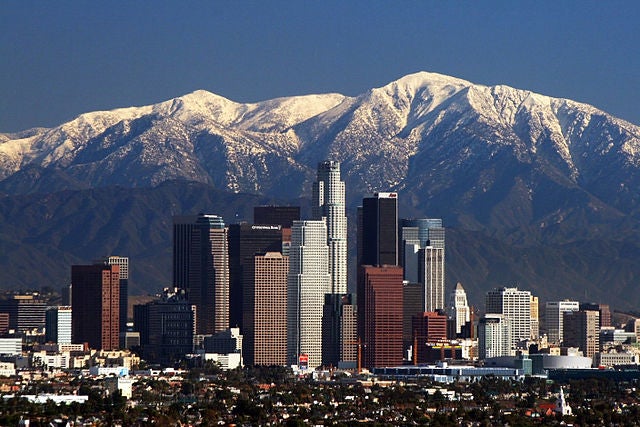 Cities across the U.S. are taking the reins on climate leadership, and Los Angeles has emerged as a hotbed for new solutions that will improve air quality and move the needle toward reaching local and state climate goals.
Cities across the U.S. are taking the reins on climate leadership, and Los Angeles has emerged as a hotbed for new solutions that will improve air quality and move the needle toward reaching local and state climate goals.
Strong mayoral commitment across the country
Los Angeles Mayor Eric Garcetti has made it clear that growing the city sustainably is a priority. In his State of the City address in April, he assured that “if the White House pulls out of the Paris climate agreement, we’re going to adopt it right here in L.A.” – and so far he has shown commitment to that promise. The Mayors National Climate Action Agenda, co-founded by Garcetti, established a network of 367 U.S. mayors and counting, representing over 67 million Americans, committed to implementing the Paris climate agreement of limiting atmospheric temperature increase to 1.5 degrees Celsius in their own localities. This commitment from cities across the country demonstrates that local solutions are leading the way, and Los Angeles is at the forefront.
Looking to a clean energy future in the City of Angels
Under the LA Sustainability Plan, Los Angeles must cut greenhouse gas emissions by 45% by 2025, 60% by 2035 and 80% by 2050. A crucial part of reaching these aggressive goals is transitioning to a clean energy future. To that end, the Los Angeles Department of Water and Power (LADWP) in partnership with the National Renewable Energy Laboratory (NREL), launched a study to analyze how the largest municipal utility in the U.S. can run on 100% clean energy.
LADWP has already committed to eliminating its dependence on coal by 2025, and now this study – in combination with a roadmap to get L.A. powered by clean energy resources – will ensure the region’s reliance on other fossil fuels like natural gas and crude oil also decreases, a critical step in reducing harmful emissions.
More than 4 million people and almost 500,000 businesses are located in Los Angeles – and delivering affordable, reliable, clean energy to this massive population will be a challenge. But by integrating more renewables onto the grid and focusing on reducing emissions, the city can keep energy bills low while improving air quality and creating more opportunity for clean energy businesses.
Los Angeles County tests avenues for deploying more clean energy
Not only is the city seriously looking into how to decrease fossil fuel energy usage, but the County of Los Angeles is also testing models. In April, the Los Angeles County Board of Supervisors approved a plan to drive more renewable energy into the county, allocating $10 million to get the Community Choice Aggregator (CCA) program up and running. The program plans to bring together several cities within the county to purchase clean electricity in the wholesale power market as an alternative to purchasing electricity directly from local investor owned utilities, in order to create a greener electricity mix.
Coordinated state and local action is a force to be reckoned with
California as a state has a goal of reducing greenhouse gas emissions by 40% and getting at least half of its energy from renewables by 2030. With SB 100 now making its way through the legislature, California has the opportunity to set an ambitious target of reaching 100% clean energy by 2045.
Los Angeles’ local actions fit squarely into the state’s goals. In some cases they are more ambitious and may push California to reach even higher ground. These local efforts also signal other cities across the country that transitioning to a clean energy future is not only possible but is already happening.
State and local targets are meant to reduce our reliance on fossil fuels, improve air quality, and spur innovation in renewable technology – an outcome that has been observed over the last decade as California has integrated the most renewables onto the grid out of any other state in the country, all while steadily increasing jobs and becoming the sixth largest economy in the world. Last year, 27% of the state’s electricity came from wind, solar, geothermal, bioenergy, and hydroelectric sources. We now have the ability to grow that percentage and make an even greater impact.
Taking action when it counts
Progress in this area can’t come soon enough. Last year, California endured a fifth consecutive year of its worst drought in over a millennium, followed by a deluge of rain and snow that broke records dating back 122 years. Following this torrent of rain, the state has repeatedly seen massive forest fires and states of emergency. With advancing climate change, these seesaw conditions are likely to continue, causing real problems for the Golden State. Coupled with extreme heat waves, expansive wild fires, increasing sea level rise, and fluctuating food production, California has a lot at stake. Additionally, poor air quality, which is exacerbated by rising temperatures, continues to plague Los Angeles which once again ranks as the city with the worst ozone pollution in the country.
With so much on the table, it is imperative for Los Angeles to transition from fossil fuels to clean energy. While there will be challenges in navigating this goal, the leadership the city is demonstrating shows us that Los Angeles is up for the challenge.









